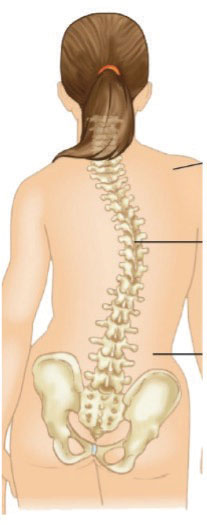Spinal Asymmetry
What is spinal asymmetry?
Spinal asymmetry is a common condition that affects many children and adolescents. Simply put, it is a curvature of the spine. When viewed from the front, a spine usually looks like the letter “I”. A spine with scoliosis curves to the right or the left, looking more like the letter “C” or “S”. Scoliosis often develops during puberty when kids are growing very quickly. Small curves occur in boys and girls equally, however, girls are more likely to go on to develop larger curves that need to be treated.
Often times, a curve will initially get discovered at a school screening or a regular check-up with the pediatrician. It is rarely associated with pain, and kids with scoliosis are still able to do all the activities and sports that kids without scoliosis can do.

What may spinal asymmetry look like?
- Uneven shoulders
- Curve of the bones on the back
- Mild waist asymmetry
- A small bump on the back with leaning forward
How is spinal asymmetry treated?
If there is a concern for spinal asymmetry or scoliosis, x-rays will be ordered to investigate further. The x-rays will allow your doctor to measure any curves in the spine, as well as see how much bone growth is still possible.
Spinal asymmetry does not require treatment and may be considered a normal finding on an x-ray. Children with spinal asymmetry can be monitored by their pediatrician at their regular well visits, or at periodic follow-up appointments with the spine doctor. This allows the doctor to assess for any significant changes to their back alignment.
Generally once bone growth is nearly done, the chance of spinal asymmetry worsening is extremely low. Depending on the degree of the curve, family history, and growth remaining for the child, your doctor will determine the best next steps for you. This is because while there is still a lot of growth remaining, spinal asymmetry can potentially change and become scoliosis, which may require a different treatment.
- Spinal Asymmetry (less than 10 degrees): About 10 percent of the population has a very small curve, less than 10 degrees, which is called spinal asymmetry. This does not require any treatment at all.
- Mild curves (10 to25 degrees) In most cases of scoliosis, the curves are mild. Regardless of how much growth is left, the only treatment needed is observation.
- Moderate curves (25 to 45 degrees) If the curve falls into the moderate category and your child is almost done growing, the treatment is still observation. Since there is not much growing left, it is unlikely that it will get worse and your doctor will monitor the curve with x-rays on a regular basis. If there is still a significant amount of growth left, your doctor may recommend bracing.
- Progressive curves (greater than 45 degrees) Large curves, also called progressive curves, typically require a surgery called “posterior spinal fusion”. This is because without stabilization the curve can continue to worsen.
| Maturity/Severity |
Mild
(10-25 degrees) |
Moderate
(25-45 degrees) |
Progressive
(>45 degrees) |
| Significant growth potential |
Observation |
Bracing |
Surgery |
| Little growth potential |
Observation |
Observation |
Surgery |
This page was last updated on: June 03, 2025 04:26 PM